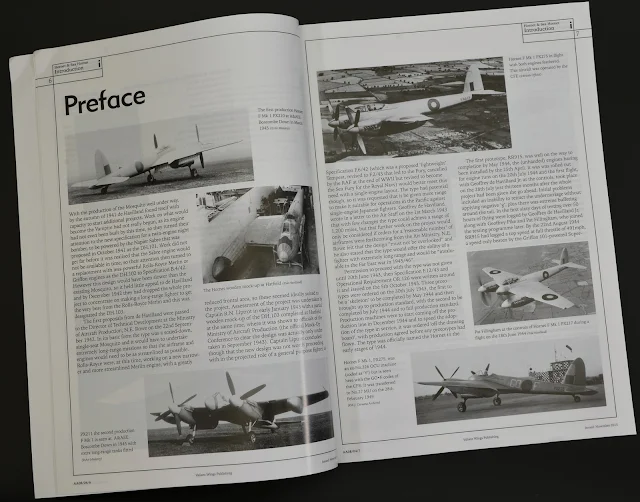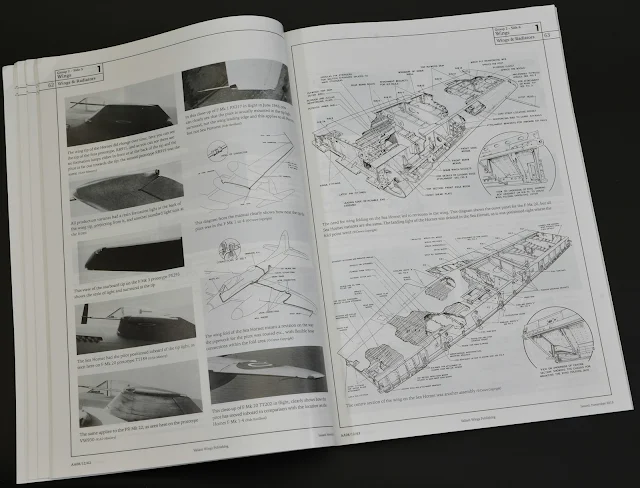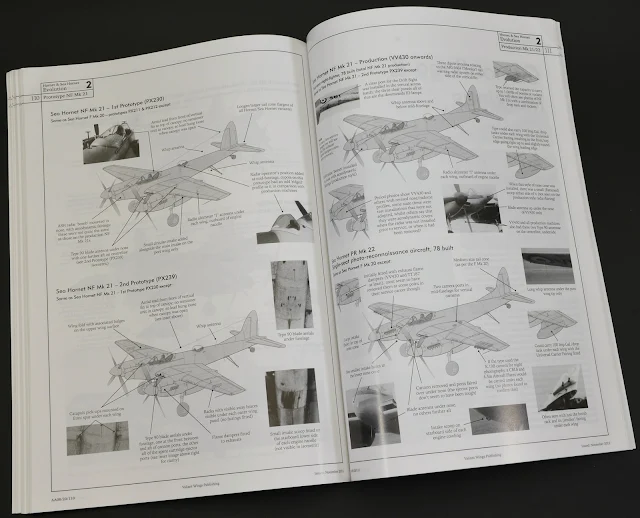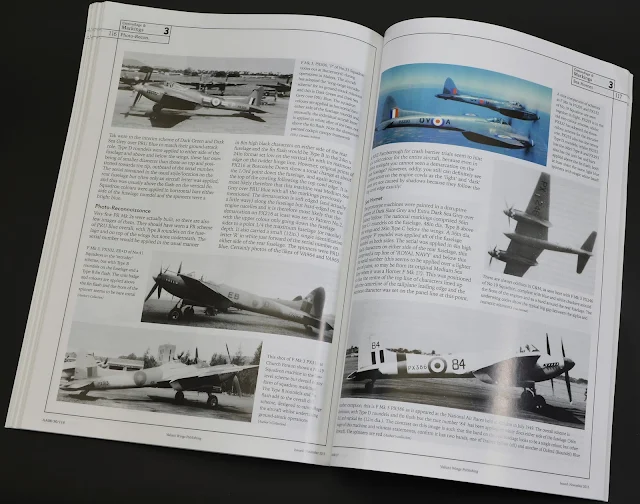Valiant Wings Publishing’s new book on the de Havilland
Hornet & Sea Hornet interested Gary more than a little as a book to review, partially because
he had seen other books in this series, and partly ‘cos he liked this airframe.
Click on to see if exactly what he thought about this new book in his review.
Read n’ Reviewed :
The de Havilland Hornet & Sea Hornet - A Detailed Guide to the RAF & FAA's Last Twin-engine Fighter
The de Havilland Hornet & Sea Hornet - A Detailed Guide to the RAF & FAA's Last Twin-engine Fighter
Airframe Album No.8
Valiant Wings Publishing
by Richard A. Franks
ISBN 978-0-9930908-0-6
Published: August
2015
Reviewed: December
2015
Available from: Valiant Wings Publishing
Price: £18, US$26,
EUR24, AU$37
The Airframe Album series are all built around a consistent
format and described by Valiant Wings as "books that offer everything that
modern modellers want when they are tackling a specific subject and includes:
period diagrams; data from flight manuals; data from spare parts catalogue;
walkaround images of preserved examples; fully detailed 3D isometric views of
prototype and production machines; full colour profiles and concise camouflage
and marking notes."
The de Havilland DH.103 Hornet was a twin-piston engined
fighter aircraft that further exploited the wooden construction techniques
pioneered by de Havilland's earlier Mosquito. Entering service at the end of
the Second World War, the Hornet equipped post-war RAF Fighter Command day
fighter units in the UK and was later used successfully as a strike fighter in
Malaya. The Sea Hornet was a carrier-capable version.
The softcover, 146 page, A4 format, colour contents are
broken down into the familiar 5 sections common to the Airframe Album series:
Introduction - 16 pages providing a brief narrative of the
development and operational use of the Hornet and Sea Hornet by the RAF and FAA
(Fleet Air Arm).
Technical Description - an impressive 81 pages detailed
coverage of construction and equipment
Evolution - Prototype, Production and Projected Variants -
10 pages of 3D Isometric views by Wojciech Sankowski showing all prototype and
production airframes illustrating difference between variants
Camouflage & Markings - 21 pages of colour profiles and
camouflage detail by Richard J. Caruana including side profiles, notes and
photographs
Models - 14 pages of listings of all Hornet kits,
accessories and decals produced in all scales plus builds of the Trumpeter
(1/48) and Special Hobby (1/72) kits.
The introduction section provides us with a relatively
short, but informative and easily readable, narrative on the circumstances surrounding
the genesis, development and ultimately deployment to active service of the
Hornet and Sea Hornet. One feature of the Airframe Album series that I
particularly like is the heavy use of photos throughout. As a modeller I find
myself drawn to the period images as they provide food for modelling
inspiration.
In common with the other books in the 'Airframe Album'
series, section 2 is broken into 7 groups:
Fuselage - Cockpit Interior, Canopy & Forward Fuselage,
Main & Aft Fuselage, Fuel, Pneumatic, Hydraulic & Oil systems and
Electrical, Radio & Radar Systems
Wings - Wings & Radiators, Ailerons, Flaps & Control
Linkage
Tail - Tail
Undercarriage - Main Undercarriage, Tailwheel & Arrestor
Hook
Engines, Cowling & Propeller - Engine & Propeller,
Cowling & Exhausts
Weapons - Armament, Ordnance, Sighting, Drop Tanks, Camera
Miscellaneous - Access Panels, Covers & Picketing,
Miscellaneous
Being billed as a 'technical guide' its not surprising that
section 2 with its 81 pages accounts for the majority of this book. The
illustrations, many taken directly from de Havilland manuals, are accompanied
by period photos which the author has painstakingly obtained from varied
sources such as the BAe Heritage Trust, de Havilland and British Crown
copyright.
Despite the obvious age of much of the source material it is
all printed with excellent clarity. Photos are clear, exposure and contrast is
properly reproduced on the glossy paper found in the book.
Much of the information included highlights the internal
construction used by de Havilland in the construction of the Hornet. Cutaway
diagrams and photos are used to logically explain the inner workings of the
aircraft. Probably more detail than most modellers will need but incredibly
interesting nonetheless.
The book contains no shortage of close-up
photos that show detail modellers will find invaluable. The wing fold detail
shown here will be very handy when I break open my recently purchased 1:48
Trumpeter Sea Hornet kit.
By referencing the original de Havilland operation manuals,
we get an excellent insight into not only what the parts of the aircraft look
like but also how they operate, something that we don't really need to make our
models but inside every modeller is an aviation enthusiast who loves these
little titbits of information (well I do anyway).
For those that wish to take their model to the next level,
there is more than enough detailed reference material for even the pickiest
super detailer. A good example is the 22 images (photos and drawings) that
cover the Rolls-Royce Merlin 130-series engine fitted to the Hornet.
Evolution of the Hornet during its development and service
career took the form of 4 prototype configurations (including the
testing/conversion to 'handed' engines, resulting in the propellers rotating in
opposite directions) and 4 major production variants (F Mk 1,3,4 and PR Mk 2)
of the RAF Hornet and 3 major variants (F Mk 20, NF Mk 21 and PR Mk 22) of the
Sea Hornet.
The book documents each of the variants, plus
minor/specialised variations, with twenty-four 3D isometric drawings which
include captions and callouts to highlight and explain each change.
The Camouflage and Markings section is quite a technical
coverage of the assorted schemes applied to the Hornet/Sea Hornet. Detailed
information is provided for the Prototypes, Fighter UK-based, Fighter Far East,
Photo-Reconnaissance and of course the Sea Hornet schemes.
Very specific information is provided for each scheme
covering the appropriate types of roundels (B, C etc) and fin flash markings
used. Likewise, the correct colours are specified using BS numbers which is
very helpful as most of the period photographs are in black and white.
Over 30 colour side profile drawings are provided as well as
top and scrap views. Each image is accompanied with written details about the aircraft
and its usage in service.
One of the stated goals of the Airframe Album series is to
cater for the scale modelling community. As with previous books in the series,
section 4 provides two fully documented builds. The first is in 1:72 where
Libor Jekl models the Special Hobby NF Mk 21. The second build in 1:48 by
Steven Evans is of the relatively new Trumpeter F Mk 1 kit.
One thing I noticed in this book compared to the earlier
Arado Ar 196 book I reviewed was the significantly larger 'in-progress' photos
in the modelling section. This is a very welcome change as it's much easier for
other modellers to grasp what is being done from a photo than a written
description.
As with the rest of the series the model photography is
excellent, being well lit and in focus. Each modeller provides insightful
information about their builds. Being a 1:48 modeller myself and having the
Trumpeter F Mk1 kit in my stash I was most interested this build. As we have
come to expect from Trumpeter their otherwise excellent kits are often marred
by basic mistakes which thankfully, as Steve Evans points out, are quite
fixable. One simple example that Steve points out is the "truly dreadful
fabric effect for the control surfaces. Not only is it utterly hideous to look
at, it's also completely spurious as the Hornets controls were all metal."
Verdict
Much like its siblings in the Valiant Wings 'Airframe Album'
series, this book provides a one-stop-shop of information for modellers looking
to not only build an accurate model of the Hornet but also to understand about
its history and operation with the RAF and FAA. I'm a big fan of books like
this that cover one particular aircraft in detail and I have no hesitation
recommending it as good value for money.
Gary Wickham
Thanks to Valiant Wings Publishing for
sending this to Gary for him to read and review…


















